The best smart home devices to simplify your lifestyle. Find the latest smart plugs, thermostats, and cameras that make every day more connected and secure. The Smart Revolution Inside Our Homes. The way we live has undergone a dramatic transformation in just a few years. Lights, thermostats, cameras, and even coffee makers now respond to simple voice commands or smartphone taps. What once felt futuristic has become an everyday reality, and it’s only getting smarter.
The best smart home devices seamlessly combine convenience, security, and efficiency, redefining comfort. Whether you’re managing your lighting, keeping an eye on your home from afar, or optimizing energy use, these intelligent tools make life simpler and more connected.
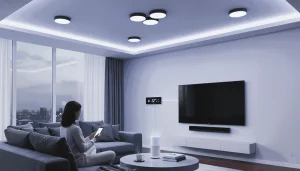
In this guide, we will explore the best home automation devices by function. We will cover security, energy management, comfort, and control. You will also learn how to build a reliable smart home system. It will be ready for the future and fit your lifestyle.
What Are Smart Home Devices?
Smart home devices are gadgets that connect to your WiFi network. They work together to automate daily tasks in your home. You can control lights, locks, heating, and entertainment using an app, your voice, or a central hub.

Unlike traditional appliances, smart home automation devices use artificial intelligence and data to learn your preferences. For example, your thermostat adjusts temperature based on your routine, or your lights dim automatically when you start a movie.
In short, Smart home devices aren’t just gadgets—they’re intelligent assistants that make your home safer, greener, and more responsive to your needs.
Smart Home Security Devices: Protecting What Matters Most

Security remains one of the biggest reasons people invest in connected living. The best home control devices in this category ensure your property is safe — even when you’re miles away.
1. Smart Security Cameras
Modern security cameras do much more than record footage. They send real-time alerts, recognize faces, and store recordings securely in the cloud.
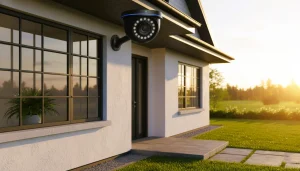
Top-rated models like Arlo Pro 5S and Google Nest Cam provide sharp 2K video quality, night vision, and motion detection. You can even view your doorstep feed from your phone or smart display.
Why it matters: Smart cameras add an essential layer of peace of mind, letting you monitor your home anytime.
2. Smart Doorbells
Devices like the Ring Video Doorbell and Eufy Security Video Doorbell combine motion sensors and two-way audio, allowing you to interact with visitors safely. If a package arrives, you’ll receive instant notifications — no more missed deliveries or unwanted surprises.
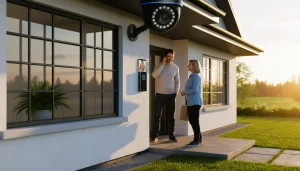
3. Smart Locks
Say goodbye to fumbling for keys. Smart locks like August Wi-Fi Smart Lock or Yale Assure Lock 2 allow remote access control through mobile apps. Some models support biometric authentication for added protection.

Expert tip: Integrate your locks, doorbell, and camera with the same app or hub for unified control.
“These are among the best home control devices for enhancing everyday security and convenience.”
Best Smart Home Devices for Energy Efficiency
Smart home technology isn’t only about comfort—it’s about conservation. The right devices help reduce energy waste, lower bills, and make sustainable living effortless.

1. Smart Thermostats
Leading brands like Ecobee Smart Thermostat Premium and Google Nest Learning Thermostat are pioneers in intelligent climate control.
These thermostats learn your daily schedule, detect occupancy, and adjust temperature accordingly. You can control them from your phone, saving energy when no one’s home and ensuring comfort when you return.
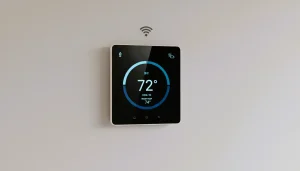
Why you’ll love it: Many models track energy reports, showing exactly how much power you save every month.
2. Smart Lighting Systems
Energy-efficient lighting systems like Philips Hue, Sengled, and LIFX allow you to adjust brightness and color temperature through mobile apps or voice commands.

Automated blinds and shades also help regulate indoor temperature by opening during daylight and closing at night, cutting down on heating and cooling costs.
These smart home automation devices create an eco-friendly environment that’s both efficient and elegant.
3. Smart Plugs and Power Strips
Even small devices contribute to power waste when left plugged in. Smart plugs such as TP-Link Kasa or Wemo Mini Plug help control outlets remotely, letting you monitor energy usage in real time.
Smart plugs turn any standard appliance into a connected one. Simply plug in lamps, TVs, or coffee makers, and control them via app or voice. Many options track power usage — helping you identify which devices consume the most electricity.
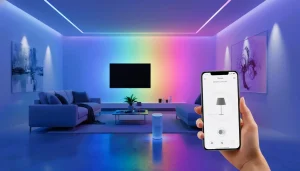
When paired with routines, they can automatically shut off at night or while you’re away.
Best Smart Home Devices for Comfort and Convenience

The best part of home automation? Effortless comfort. From lighting to entertainment, smart devices make life smoother, saving time while enhancing daily routines.
Smart technology isn’t just functional — it’s about making your life easier and more enjoyable.
a. Smart Speakers and Voice Assistants
Devices like Amazon Echo, Google Nest Audio, and Apple HomePod mini act as your home’s digital assistants. They control other smart gadgets, play music, answer questions, and manage your schedule with simple voice commands.

Imagine saying, “Hey Google, good morning,” and watching your lights brighten, thermostat adjust, and coffee maker start brewing.
b. Smart Displays
For those who prefer visual control, smart displays like the Nest Hub Max or Echo Show 15 allow you to view live camera feeds, video call family, or follow recipes while cooking.
c. Automated Blinds and Curtains
Motorized shades connect to your system, adjusting automatically based on the time of day or temperature. This not only adds comfort but also improves energy efficiency by blocking heat during the day.
d.Smart Kitchen Appliances
From WiFi coffee makers to smart ovens, modern kitchens make life easier. You can preheat the oven or check your cooking from your phone. Brands like Innit and GE Smart Appliances make it simple to manage everything with an app. Some can even suggest recipes based on available ingredients.
Smart kitchens prove that automation isn’t just about gadgets — it’s about smarter living.
Smart Entertainment Systems: Enjoy the Ultimate Experience
Entertainment is another major part of modern connected homes. The best smart home devices for entertainment combine simplicity with sophistication.
- Smart TVs
Today’s smart TVs do more than stream shows. They connect with your home system, like Alexa, Google Assistant, or Apple HomeKit. Just say, “Turn on Netflix,” and your favorite show starts right away.
2. Streaming Devices
If your current TV isn’t smart, streaming sticks like Roku Ultra, Amazon Fire TV Stick, or Google Chromecast turn it into one. They bring access to apps, games, and 4K streaming without the need for an expensive upgrade.
3. Smart Speakers & Soundbars
Pairing your smart TV with a Sonos Arc or Bose Smart Soundbar transforms your living room into a mini theater. You can even synchronize multiple speakers for whole-home audio.
Best Smart Home Devices for Centralized Control

The magic of a smart home lies in how seamlessly everything works together. To make that possible, you need the best home control devices to help connect everything in one place. Use hubs, apps, or simple interfaces
Smart Hubs
A smart hub acts as the brain of your home automation system. Devices like Samsung SmartThings Station, Aqara Hub M3, or Amazon Echo Hub connect all your smart home automation devices, allowing cross-platform compatibility

They ensure your lights, locks, thermostats, and cameras communicate effectively—even when brands differ.
All-in-One Hubs
Systems like Samsung SmartThings, Amazon Echo Hub, and Aeotec Smart Home Hub let you control lights, security, and appliances in one app. These hubs work with many platforms, such as Zigbee and Z Wave, so everything stays connected.
Mobile Apps and Dashboards
Many homeowners now prefer app-based control. Platforms like Home Assistant, Apple Home, and Google Home offer user-friendly dashboards to manage scenes and automations from one place.
For example, a “Good Night” routine might turn off lights, lock doors, and set the thermostat with a single tap.
Matter-Compatible Devices
Matter smart home devices are the newest standard for seamless integration. Matter is supported by Google, Apple, Amazon, and Samsung. It helps your smart devices work together easily. No brand issues and no setup troubles.
Future insight: As Matter adoption grows, expect faster pairing, improved reliability, and wider compatibility across devices.
Smart Home Devices for Health and Wellness
The idea of wellness now extends beyond fitness trackers — it’s about your living environment too.
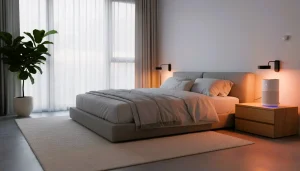
- Smart Air Purifiers
Devices like Dyson Purifier Hot+Cool or Levoit Core 600S monitor air quality and adjust filtration automatically. You can track indoor pollutants right from your smartphone.
2. Smart Mattresses and Sleep Trackers
Smart beds, such as Sleep Number 360, adapt firmness to your body position and track sleep patterns. Sync them with health apps for insights into your rest quality.
3. Smart Kitchen Appliances
From Wi-Fi-enabled ovens to voice-controlled coffee machines, smart kitchen tools make daily chores effortless. Some even suggest recipes based on what’s in your fridge.
How to Build Your Smart Home Ecosystem
If you’re new to automation, it’s best to start small and expand gradually.
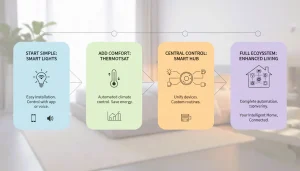
Step 1: Begin with a Voice Assistant
Pick a voice platform — Alexa, Google Assistant, or Siri. This becomes your control center for other devices.
Step 2: Add Devices That Solve Problems
Focus on convenience first, such as smart lights, plugs, or a thermostat. Then move on to advanced options like security cameras and hubs.
Step 3: Ensure Compatibility
When buying new gadgets, make sure they’re compatible with your existing ecosystem. The Matter standard will simplify this in the future.
Step 4: Secure Your Network
Change default passwords, enable two-factor authentication, and keep firmware updated. Cybersecurity is essential when everything’s connected.
Step 5: Optimize with Automation
Create routines for everyday tasks. Turn off all lights at night, set the temperature automatically, or schedule your morning lights.
Always ensure new devices are compatible with your chosen platform, Alexa, Google Assistant, Apple HomeKit, or Matter.
Common Smart Home Mistakes to Avoid

Even advanced setups can fail if not managed properly. Avoid these common pitfalls to keep your system running smoothly:
- Ignoring Compatibility: Not all devices work with each ecosystem — always check before buying.
- Overloading Wi-Fi Networks: Use a strong router or dedicated smart hub to prevent lag.
- Neglecting Updates: Firmware and app updates fix bugs and enhance security.
- Weak Passwords: Always use strong, unique credentials to secure your smart home data.
- Skipping Privacy Settings: Review app permissions and disable unnecessary data sharing.
By avoiding these issues, your best home automation devices will operate efficiently for years.
The Future of Smart Homes
The next wave of smart home innovation will make automation even more intelligent, integrated, and eco-conscious.

As artificial intelligence and IoT evolve, smart homes are becoming even more adaptive. Imagine a system that learns your habits — adjusting lighting, security, and energy use automatically.
We’re already seeing AI-driven assistants predicting needs, energy-efficient appliances reducing carbon footprints, and advanced sensors improving home health.
In the next few years, connected homes will become the default — blending sustainability, accessibility, and convenience like never before.
FAQ: Best Smart Home Devices

-
What is a smart home device?
A smart home device is a connected gadget that uses Wi-Fi, Bluetooth, or Zigbee to communicate with other devices or apps. It can be controlled remotely through your phone or voice assistants like Alexa or Google Assistant. Examples include smart thermostats, plugs, lights, and security cameras.
-
Which smart home system is best?
The best smart home system depends on your ecosystem preference. Amazon Alexa, Google Home, and Apple HomeKit are the most popular platforms. For the most flexibility, look for Matter-compatible devices, which work across multiple systems without brand restrictions.
-
Are smart home devices worth it?
Yes, they’re worth it — especially if you value convenience, energy efficiency, and security. Smart thermostats reduce energy bills, automated lights enhance comfort, and connected locks and cameras improve safety. Over time, these devices often pay for themselves in savings and efficiency.
-
Can I start with just one smart home device?
Absolutely. You don’t need a full setup from day one. Start with an easy entry point like a smart plug or voice assistant speaker. Once you’re comfortable, you can gradually expand to lighting, thermostats, and security systems.
-
Do smart home devices work without the internet?
Some do, but most rely on Wi-Fi or cloud connectivity for full functionality. Basic automations (like turning lights on or off) may still work offline, but advanced features like voice control or remote monitoring usually require internet access.
-
Are smart home devices secure?
Smart devices are generally secure if you follow good practices:
- Change default passwords.
- Enable two-factor authentication.
- Regularly update firmware.
Most modern systems use strong encryption, but your network’s security is just as important as the device itself.
-
What are Matter smart home devices?
Matter is a new connectivity standard supported by Google, Apple, Amazon, and Samsung. It allows devices from different brands to work together easily — eliminating compatibility issues. If you’re building a new setup, choosing Matter-ready devices is a smart long-term move.
-
How much does it cost to set up a smart home?
Costs vary depending on your goals. A basic setup (smart speaker, plugs, and lights) can start under $200. A fully connected home with security, climate control, and automation hubs can range from $1,000 to $3,000 or more. The key is to build gradually based on your priorities.
-
Do smart devices use a lot of electricity?
No, they typically consume very little power. In fact, many devices like smart thermostats and lighting systems help reduce overall energy usage. For example, motion sensors can automatically turn lights off when no one’s home.
-
What are the best smart home devices for beginners?
If you’re just starting, begin with:
- A smart speaker (Amazon Echo, Google Nest Mini)
- Smart bulbs (Philips Hue, Sengled)
- Smart plugs (TP-Link Kasa, Wemo)
These devices are affordable, easy to set up, and form a foundation you can expand on later.
Building a smarter home doesn’t require a massive budget or complex setup. The smart home devices are designed to make your life safer, easier, and more energy-efficient — one step at a time.

Start small with smart lights or thermostats, then expand to security and entertainment. Whether you call it a connected home device, an automated living space, or simply a smarter lifestyle, it’s about creating a home that works for you.
